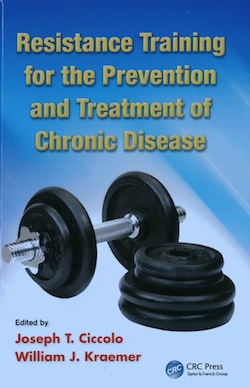Vive la Resistance
TC's Joseph Ciccolo weighs in on the importance of strength training
By Siddhartha Mitter
A cursory glance at the sneaker section in any athletic store suggests that our society has awakened to the importance of even minimal amounts of aerobic exercise.
But what about the value of a few squats, or of working on a Universal or with free weights? Resistance training – the term for strength work using weights, elastic bands, or the body’s own weight – gets far less attention than aerobic exercise, and its benefits are less widely recognized.
In Resistance Training for the Prevention and Treatment of Chronic Disease, Joseph Ciccolo, Assistant Professor of Applied Physiology and director of TC’s Applied Exercise Psychology Laboratory, and William J. Kraemer of the University of Connecticut, give a strength training a major lift. With chapters from 29 contributors on how resistance training can help deal with a dozen major chronic conditions – including cancer, diabetes, HIV/AIDS, Parkinson’s, and depression and anxiety – the book is both a review of existing research in the field (much of it quite new) and a plea for more scholars to study the potential of resistance training and more health care providers to recommend it.
“Resistance training is the bastard child of physical activity,” Ciccolo says. “It’s too often thought of as an add-on.” For example, as he and Kraemer point out in their introduction, the U.S. Department of Health and Human Services’ physical activity guidelines, issued in 2008, emphasize aerobic activity, with recommended weekly amounts of moderate or vigorous aerobic exercise. Only the fourth and final guideline calls for “muscle-strengthening activities” at least twice a week, as these “provide additional health benefits.”
Perhaps partly as a result, Americans demonstrate a marked preference for aerobic exercise. According to the 2011 National Health Information Survey (NHIS), 48.4 percent of American adults met the guidelines for aerobic activity – hardly an encouraging number, but far better than the mere 24.1 percent who met the guidelines for resistance training and the 20.6 percent met the guidelines for both. And the numbers on research on physical activity are similarly skewed, Ciccolo says.
“There are 15 or 20 aerobic exercise studies for every resistance training study,” Ciccolo says. “Partly that’s because aerobic exercise is easier to research, since everyone knows how to walk.”
The emphasis on aerobic exercise is particularly counter-productive for the growing number of people with physical limitations that prevent them from performing it.
“We’re moving into a time when a lot of people have things that keep them from doing aerobic exercise, such as arthritis, or a bum ankle or knee,” Ciccolo says. “The message that people should primarily focus on aerobic exercise is a poor one for an aging population.”
Meanwhile, resistance training can help people with certain chronic conditions. Ciccolo and Kraemer summarize research on such issues as the benefits of resistance training on arterial health for sufferers of cardiovascular disease, on endurance and ability to do daily tasks for people with chronic obstructive pulmonary disease, and on strength gains and pain alleviation for fibromyalgia sufferers.
The field has plenty of room to grow, Ciccolo says. Breakthroughs in other areas of medical research are facilitating studies that could not previously have been conducted. For instance, resistance training was long considered “too taxing” for HIV/AIDS patients, but improvements in medication now make it a viable option that may provide some distinct health benefits. Advances in imaging technologies could confirm the beneficial impact of resistance training on the brain, with positive implications for numerous conditions.
Ciccolo doesn’t want to spark a war over the relative merits of aerobic exercise and resistance training. Both kinds of activity clearly are beneficial. But right now “we’re missing a big chunk of people who can benefit,” he says. “If physical activity is a major message, we should promote all forms of it.”
Published Monday, Dec. 9, 2013

